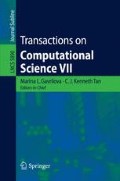Abstract
The dielectric medium consisting of rigidly polarized molecules is treated as a 3D disordered spin system. For investigation of statistical properties of this system on a scales of space-time periods of standing electromagnetic wave a microscopic approach has been developed. Using Birgoff’s ergodic hypothesis the initial 3D spin-glass problem is reduced to two conditionally separated 1D problems along the external electromagnetic field’s propagation. The first problem describes a quantum dynamics of 1D disordered N-particles system with relaxation in 3D media, while the second one describes a statistical properties of ensemble of disordered steric 1D spin-chains. On the base of constructions which are developed in both problems, is calculated the coefficient of polarizability related with the collective orientational effects of dipoles in external standing electromagnetic field. The Clausius-Mossotti equation for effective dielectric constant on the space-time scale’s of external standing field is generalized. The effective parallel algorithm for computation of stationary dielectric constant is proposed.
An Erratum for this chapter can be found at http://dx.doi.org/10.1007/978-3-642-11389-5_10
Access this chapter
Tax calculation will be finalised at checkout
Purchases are for personal use only
References
Apollonov, V.V., Artemyev, A.I., Feodorov, M.V., Shapiro, E.A.: Free-electron laser exploiting a superlattice-like medium. Optic Express 3, 162–170 (1998)
Morozov, G.V., Sprung, D.W.L., Martorell, J.: Optimal band-pass filter for electrons in semiconductor superlattices. J. Phys. D: Appl. Phys. 35, 2091–2095 (2002)
Rasporin, A.S., Cui, H.L.: Domain theory of self-induced transparency in a semiconductor superlattice. Phys. Rev. B 68, 045305–045311 (2003)
Shen, M., Cao, W.: Acoustic bandgap formation in a periodic structure with multilayer unit cells. J. Phys. D: Appl. Phys. 33, 1150–1154 (2000)
Zhang, X., et al.: Comparison of experimental and Monte Carlo simulated BSE spectra of multilayered structures and ’in-depth’ measurements in a SEM. J. Phys. D: Appl. Phys. 35, 1414–1437 (2002)
Mkrtchyan, A.R., et al.: Nanotechnologies in the area of physics, chemistry and biotechnology. In: Fifth ISTC SAC Seminar, St. Petersburg, Russia, pp. 202–205 (2002)
Gevorkyan, A.S., Hu, C.-K.: On a mathematical approach for the investigation of some statistical phenomena of a disordered 3D spin system in the external field. In: Barsegian, G.A., et al. (eds.) Proceedings of the ISAAC Conf. on Analysis, Yerevan, Armenia, pp. 165–178 (2004)
Schnatterly, S.E., Tarrio, C.: Local Fields in Solids: Microscopic Aspects for Dielectrics. Rev. of Mod. Phys. 64, 619–622 (1992)
Kobelev, V.P., Selin, Yu.I., Shaimardanov, A.M.: Application of Superposition Principle to Fields in Dielectric Medium. Sov. Phys. Techn. Phys. 26, 1432–1437 (1981)
Briggs, J.: Effective Electric Field in an Inhomogeneous Medium. Phys. Rev. A 18, 1577–1590 (1978)
Barrera, R.G., Mello, P.A.: Statistical Interpretation of the Local Field Inside Dielectrics. Amer. J. of Phys. 50, 165–169 (1982)
Chen, Z., Sheng, P.: Local Fields in Random Dielectrics: Distribution Characteristics and the Effects of Microstructure. Phys. Rev. B. 43, 5735–5746 (1991)
Kittel, Ch.: Introduction to Solid State Physics. Wiley, J., and sons, Inc., New York (1962)
Griffith, D.J.: Introduction to Electrodynamics, p. 192. Prentic Hall, New Jersey (1989)
Becker, R.: Electromagnetic Fields and Interactions. Dover, New York (1972)
Tu, Y., Tersoff, J., Grinstein, G.: Properties of a Continuous-Random-Network Model for Amorphous Systems. Phys. Rev. Lett. 81, 4899–4902 (1998)
Lifshits, I.M., Gredeskul, S.A., Pastur, L.A.: Introduction to the theory of disordered systems, Nauka, Moscow (1982) (in Russian)
Gevorkyan, A.S.: Exactly solvable models of stochastic quantum mechanics within the framework of Langevin-Schreodinger type equation, Analysis and applications. In: Barsegian, G., Begehr, H. (eds.) Proceeding of the NATO Advanced research workshop, Yerevan 2002, NATO Science publications, pp. 415–442. Kluwer, Dordrecht (2004)
Berthier, L., Young, A.P.: Time and length scales in spin-glass, October 30 (2003), arXiv; cond-nat/0310721 v1
Pavlov, P.V., Khokhlov, A.F.: Solid State Physics, High School Book Company, Moscow (2000) (in Russian)
Korn, G.A., Korn, T.M.: Mathematical Handbook for Scientists and Engineers. McGraw-Hill, New York (1968); Nauka, Moscow (1984)
Klyatskin, V.I.: Statistical description of dynamical systems with fluctuating parameters, Nauka, Moscow (1975) (in Russian)
Zachariasen, W.H.: J. Am. Chem. Soc. 54, 3841–3851 (1932)
Edwards, S.F., Anderson, P.W.: Short-Range Ising Model of Spin Glasses. J. Phys. F 9, 965–974 (1975)
Binder, K., Young, A.P.: Spin glasses: Experimental facts, theoretical concepts, and open questions. Rev. Mod. Physics 58(4), 801–976 (1986)
Dasgurta, Ch., Ma, S.-k., Hu, C.-K.: Dynamic properties of a spin-glass model at low temperatures. Phys. Rev. B 20, 3837–3849 (1979)
van Hemmen, J.L.: In: van Hemmen, J.L., Morgenstern, I. (eds.) Proceedings of the Heidelberg Coloquium on Spin Glasses. Lecture Notes in Physics, vol. 192. Springer, Berlin (1983)
Berg, B.A., Neuhaus, T.: Multicanonical ensemble: A new approach to simulate first-order phase transitions. Phys. Rev. Lett. 68, 9–12 (1992)
Fedoryuk, M.V.: Method of saddle-point, Moscow, Nauka (1977) (in Russian)
Author information
Authors and Affiliations
Editor information
Editors and Affiliations
Copyright information
© 2010 Springer-Verlag Berlin Heidelberg
About this chapter
Cite this chapter
Gevorkyan, A.S., Hu, CK., Flach, S. (2010). Retracted: New Mathematical Conception and Computation Algorithm for Study of Quantum 3D Disordered Spin System under the Influence of External Field. In: Gavrilova, M.L., Tan, C.J.K. (eds) Transactions on Computational Science VII. Lecture Notes in Computer Science, vol 5890. Springer, Berlin, Heidelberg. https://doi.org/10.1007/978-3-642-11389-5_8
Download citation
DOI: https://doi.org/10.1007/978-3-642-11389-5_8
Publisher Name: Springer, Berlin, Heidelberg
Print ISBN: 978-3-642-11388-8
Online ISBN: 978-3-642-11389-5
eBook Packages: Computer ScienceComputer Science (R0)

